The UIAA’s Summit Series explores a number of the world’s most iconic and challenging mountains and mountain ranges. Produced by the UIAA Medical Commission, they offer information on numerous areas including ascent profiles, acclimatization and preparation. The papers also offer links to live information and introduces other useful areas of UIAA expertise.
About Fuji
Mount (Mt.) Fuji (3,776 m), in Japanese Fujisan, is the highest mountain in Japan. It is an isolated mountain located near the Pacific Ocean coast in Shizuoka and the Yamanashi prefectures of central Honshu, about 100km (60 miles) southwest of Tokyo. It is an active stratovolcano, whose last eruption was in 1707. Mount Fuji was designated as a UNESCO World Heritage site in 2013.
Mt. Fuji is a worldwide symbol of Japan and climbed by more than 200,000 hikers every year. Those who climb Mt. Fuji during the ‘opening period’ (the designated climbing season) from early July to early September do not need to have significant experience in rock climbing or climbing in snow. However, during this period, trails can still be closed due to rain or wind, so it is necessary to time and plan one’s ascent carefully. Huts are open in the opening period, but they close once the climbing season has concluded in September.
It is not impossible to climb Mt. Fuji when the trails and huts are closed. However, punishing winds and heavy snowfall are common, and in such circumstances it is very dangerous. This can be accompanied by a high risk of a falling particularly on the steeper slopes.
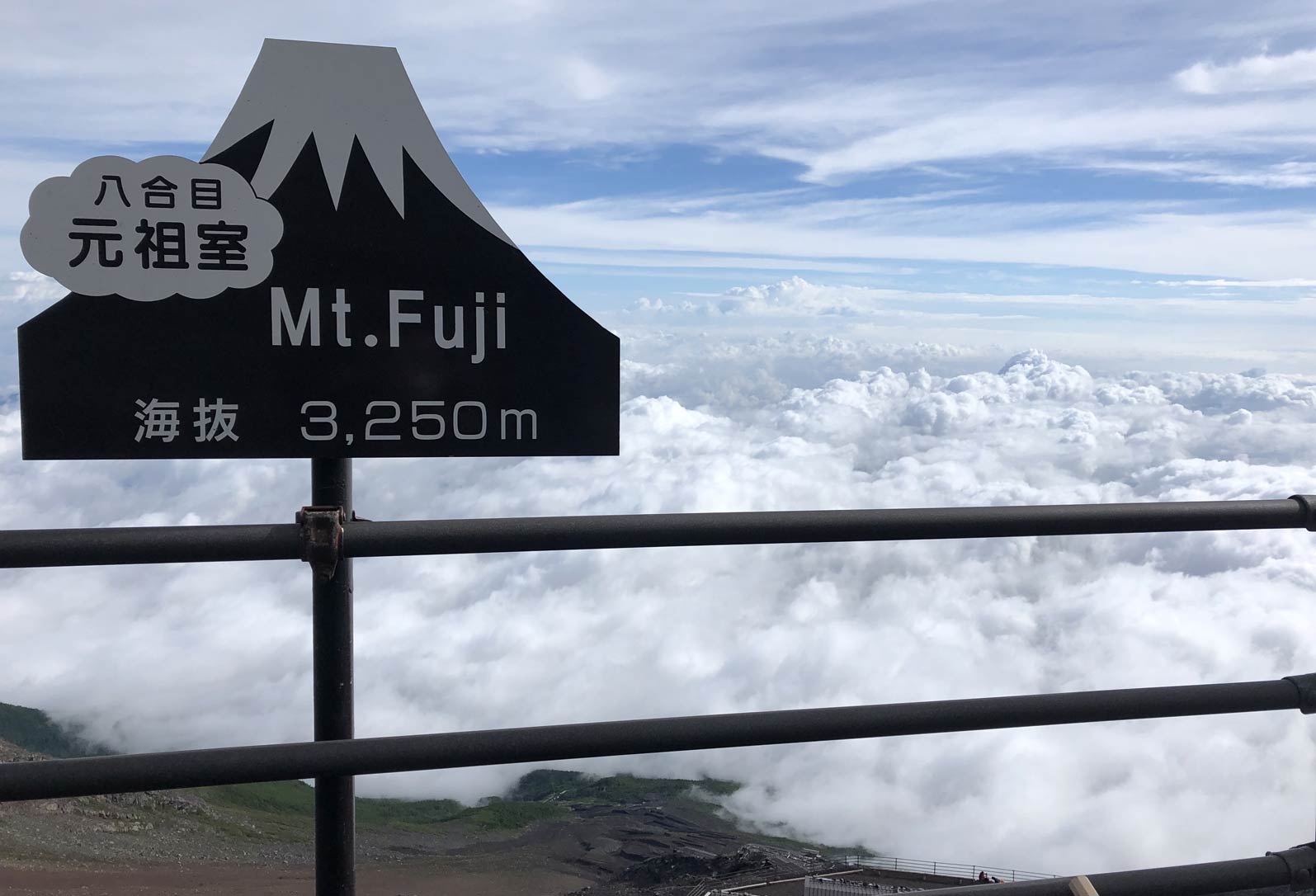
Ascent of Mount Fuji
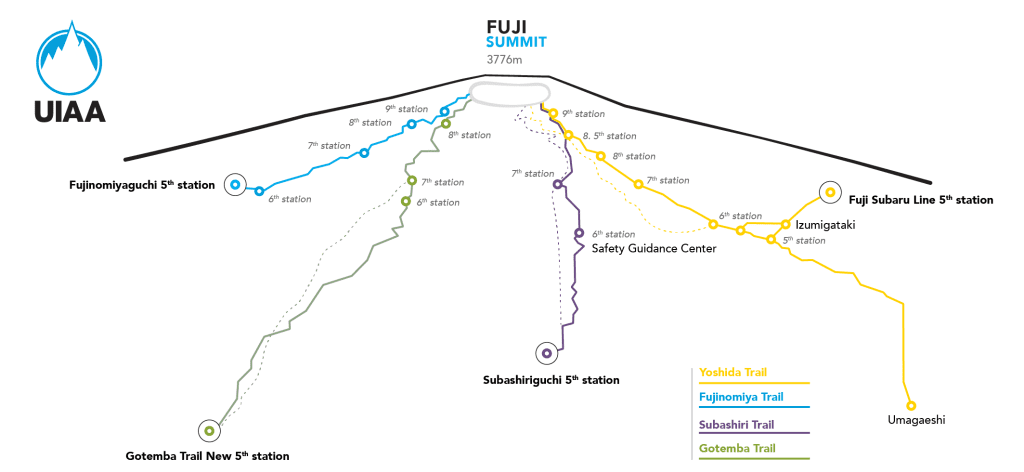
Access
There are four trails leading to the summit of Mt. Fuji. Fuji, divided into ten stations.
Each trail has its trailhead as the point of starting.
-
- Yoshida Trailhead: Fuji-Subaru Line 5th station (2,300 m)
- Subashiri Trailhead: Subashiri Trail 5th station (2,000 m)
- Gotemba Traihead: Gotemba Trail New 5th station (1,450 m)
- Fujinomiya Trailhead: Fujinomiya Trail 5th station (2,400 m)
Introduction of the four trails
Yoshida Trail: This is the most popular and accessible trail. Direct buses bring visitors to the Yoshida trailhead from Tokyo. There are the largest number of mountain huts and amenities along this trail. The ascent time to the summit is about six hours, and descent time is about four hours. Lots of people climb this trail to admire the sunrise at the summit. As a result, it can be crowded during the high season. It joins up with Subashiri trail near the original 8th station. When you descend, you need to go left at the fork.
Subashiri Trail: It is located on the eastern side of Mt. Fuji, and is not as crowded as the Yoshida trail with fewer huts and amenities. It joins up with Yoshida trail near the original 8th station. When you descend, you need to go right at the fork. Ascent and descent time is six and three hours respectively.
Gotemba Trail: This is the longest route, and it takes eight hours or more to reach the summit because its trailhead is located several hundred meters lower than other trailheads. There are no huts between Oishi-Chaya (near the new 5th station) and the 7th station. It is less crowded, and you can park your car at Gotemba parking lot in Gotemba Trail new 5th station.
Fujinomiya Trail: Its trailhead is higher than other trailheads and the ascent time is the shortest (about 5 hours), and there are huts at every station. However the trail for ascent is the same as the trail for descent, and it is crowded.
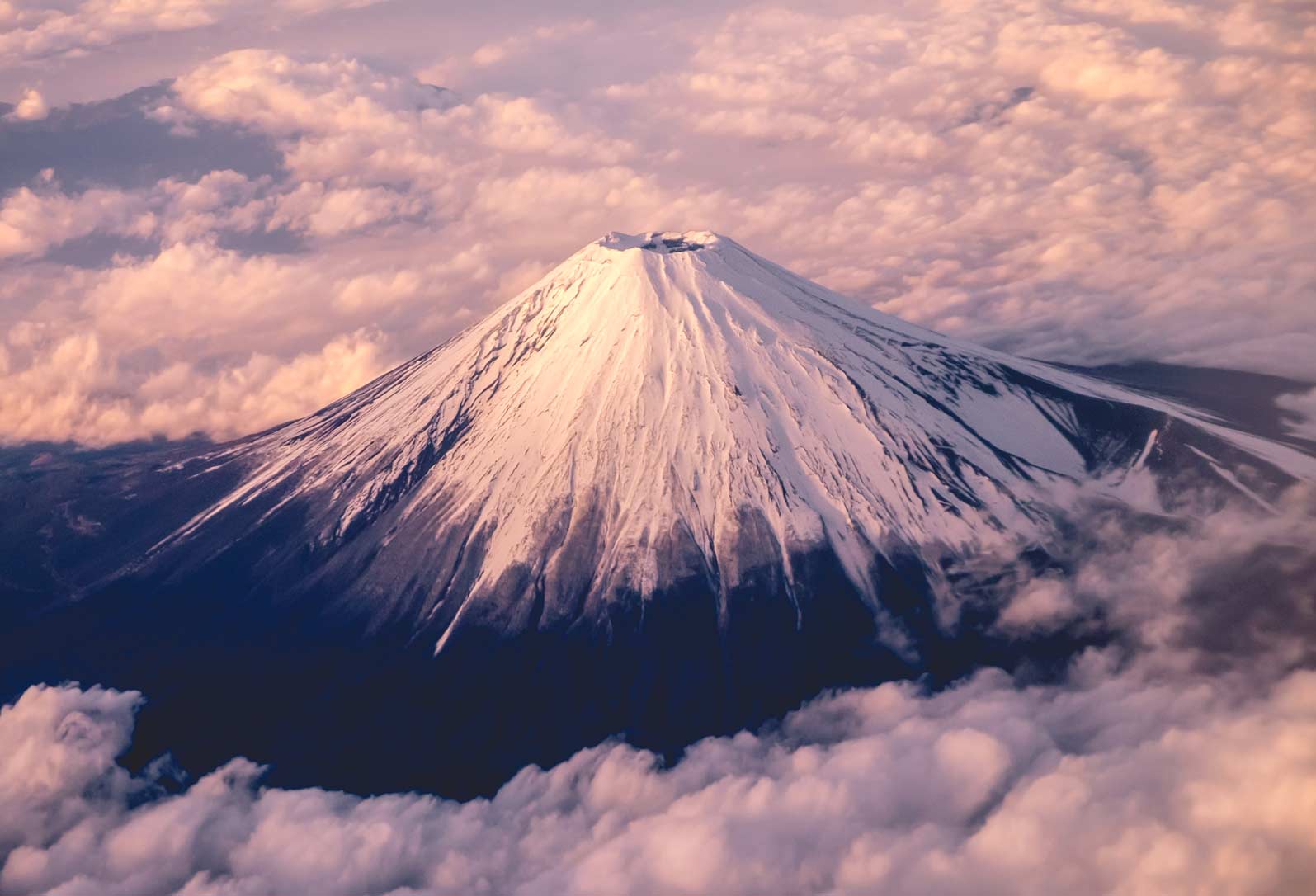
Access
Yoshida Trail: From Fujisan Station or Kawaguchiko Station of Fujikyu Railway, you can get to Fuji-Subaru Line 5th station by the mountain bus. You can get on the Expressway Bus at Shinjuku Expressway Bus Terminal, Yokohama Station, Hiyoshi Station, Center Kita Station, Tama Plaza and Ichigao Station, and reach the Fuji-Subaru Line 5th station.
When you drive to Fuji-Subaru Line 5th station, get off the Chuo Expressway at Kawaguchiko Interchange, or get off the Higashi Fujigoko Toll Road at Fujiyoshida Interchange. You can reach the Fuji-Subaru Line the 5th station through Fuji-Subaru Line (Toll Road). It is not open 24 hours a day during the mountain-opening period, so please note the business hours. The number of vehicles admitted may be restricted.
Subashiri Trail: From the Gotemba Station of JR Gotemba Line or Shinmatsuda Station of Odakyu Line, you can reach the Subashiri Trail 5th station by the mountain bus. When you drive to the Subashiri 5th station, until July 14 and after 1 September get off the Higashi Fujigoko Toll Road at the Subashiri Interchange, and head there via the Fuji-azami Line. From 15 July to 31 August, alight at the Higashi Fujigoko Toll Road at the Subashiri Interchange, head towards the Michinoeki Subashiri, and make a transfer to the shuttle bus for the Subashiri 5th station.
Gotemba Trail: From the Gotemba Station of JR Gotemba Line, you can get to Gotemba Trail 5th station by the mountain bus. When you drive to Gotemba new 5th station, alight at the Higashi Fujigoko Toll Road at the Subashiri Interchange, or get off at the Tomei Expressway at the Gotemba Interchange, and head there through Route 138, theGotemba-Fuji Park Line and Mt. Fuji Skyline.
Fujinomiya Trail: From Mishima Station or Shin-Fuji Station of JR Shinkansen Line, Fuji Station of JR Tokaido Line, or Fujinomiya Station of JR Minobu Line, you can get to the Fujinomiya 5th station by the mountain bus. You can also get there by the Expressway Bus from Shizuoka Station of JR Tokaido Line.
When you drive to the Fujinomiya 5th station, until 8 July and after 1 September, alight the Tomei Expressway at the Gotemba Interchange or Susono Interchange, head to the Fujinomiya 5th station through the Mt. Fuji Skyline. When you get off at the Tomei Highway at the Fuji Interchange or alight at the Shin-tomei Highway at the Shinfuji Interchage, you can also get there through Nishi-Fuji Toll Road (Rout 139) and the Mt. Fuji Skyline.
From 9 July to 10 September, get off the Tomei Expressway at Gotemba Interchange or Susono Interchange, get to Mizugatsuka parking lot, and make a transfer to the shuttle bus for the Fujinomiya 5th station. When you get off Tomei Highway at Fuji Interchange, or get off Shin-tomei Highway at Shinfuji Interchage, you can also get to Mizugatsuka parking lot and change the shuttle bus for the Fujinomiya 5th station.
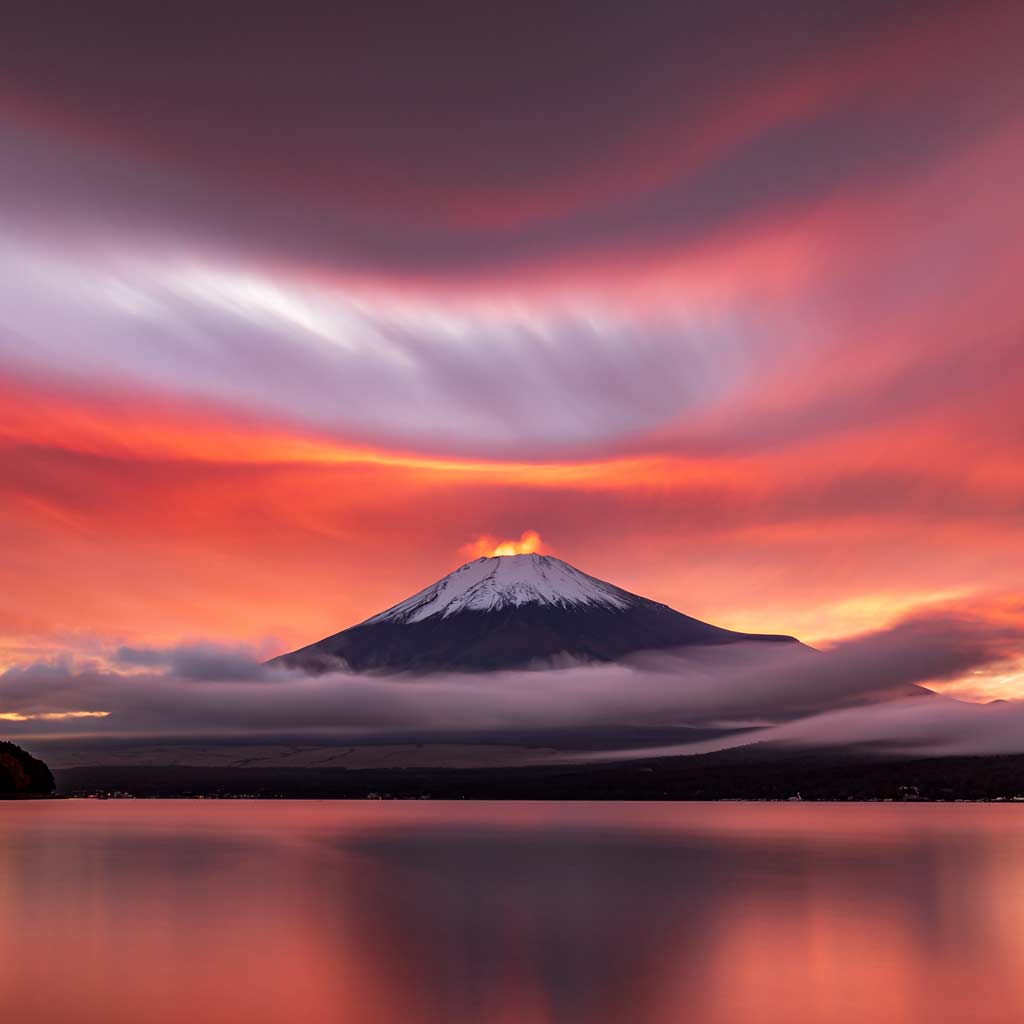
Route Description
Yoshida Trail: The trail is located on the north side of Mt. Fuji in Yamanashi Prefecture. It is almost horizontal between Fuji-Subaru Line 5th station and the 5th station. The trail for ascent is different from the trail for descent between the 5th station and the summit. It is relatively flat between the 5th and the 7th station. It is slightly rocky and steeper beyond the 7th station. Between the 8th station and the summit, both trails for ascent and descent are the same as Subashiri Trail.
There are many huts along the trail for ascent, but none along the trail for descent. You can use the restroom in the huts. Climbers are asked to make a contribution for using the facilities. This trail is popular with those who would like to see the magnificent sunrise. They stay at huts along 7th to 8th station before going up to the summit.
Note this trail is selected by more than half of climbers and crowded, especially beyond the Old (Original) 8th station where the Subashiri trail joins.
Approximately 1,000 people each year take a wrong turn at the junction and go down Subashiri Trail. If you go the wrong way to Subashiri Trail, you cannot go back to Fuji-Subaru Line 5th station. There is no bus which departs the Subashiri Trail 5th station and directly reaches the Fuji-Subaru Line 5th station. You have to take a taxi or change buses.
Subashiri Trail: The trail starts at the Subashiri 5th station and passes through the east side of Mt. Fuji in Shizuoka Prefecture (Oyama Town). Most of the trail for the ascent is different from the trail for the descent. Between the 8th station and the summit, both trails for the ascent and the descent are the same as Yoshida Trail. The trail is relatively flat and covered with trees up to near the 7th station.
There are nine huts along the ascending trail where you can use rest rooms (a 200-300 yen fee), and only one along the descending trail below the 7th station. However, you can access huts on the ascending trail from the descending trail. The trail is crowded beyond the old (original) 8th station where the Yoshida trail joins. This trail is also good for seeing the sunrise.
On the way down to the Subashiri 5th Station, be careful not to take the wrong way to Yoshida Trail near the 8th station. From the 7th station on the descent, the trail is a little faster and covered with sand gravel (Sunabashiri) towards the Sunaharai 5th station. It is recommended to wear appropriate footwear as gravel easily gets into shoes.
Gotemba Trail: The longest trail and located in the south-east side of Mt. Fuji in Shizuoka Prefecture (Gotemba City). There are no mountain huts or rest rooms up to the 7th station after departing Ohishi-Chaya, about ten minutes’ walk from the Gotemba Trail 5th station. This trail is accessible by private car, and you can enjoy peaceful climbing. But be careful not to lose your way in dense fog. Note that an inexperienced or weak climber might be exhausted and cannot reach the summit due to the longer distance and more sudden difference of elevation. Visitors should be mindful of dehydration.
The descent is the same as ascending trail at first, but it diverges from the 7th station and leads to Osunabashiri covered with sand gravel, where you can run off with long steps towards Jirobo.
The UIAA recommends climbing up to the summit from the Gotemba Trail 5th Station in one day and staying a night or two at the top.
Fujinomiya Trail: The Fujinomiya trail starts at the Fujinomiya 5th station and passes through the south side of Mt. Fuji in the Shizuoka Prefecture (Fujinomiya City). The Fujinomiya Trail head is the highest of all the trail heads, and the distance between the trail head and the summit is shortest. However it is rocky and steep, and the trail for the ascent is the same as trail for the descent. It can become challenging for people to pass each other. It is crowded when crossing the Yoshida Trail during the climbing season. There are huts in every station, and you can utilise amenities.
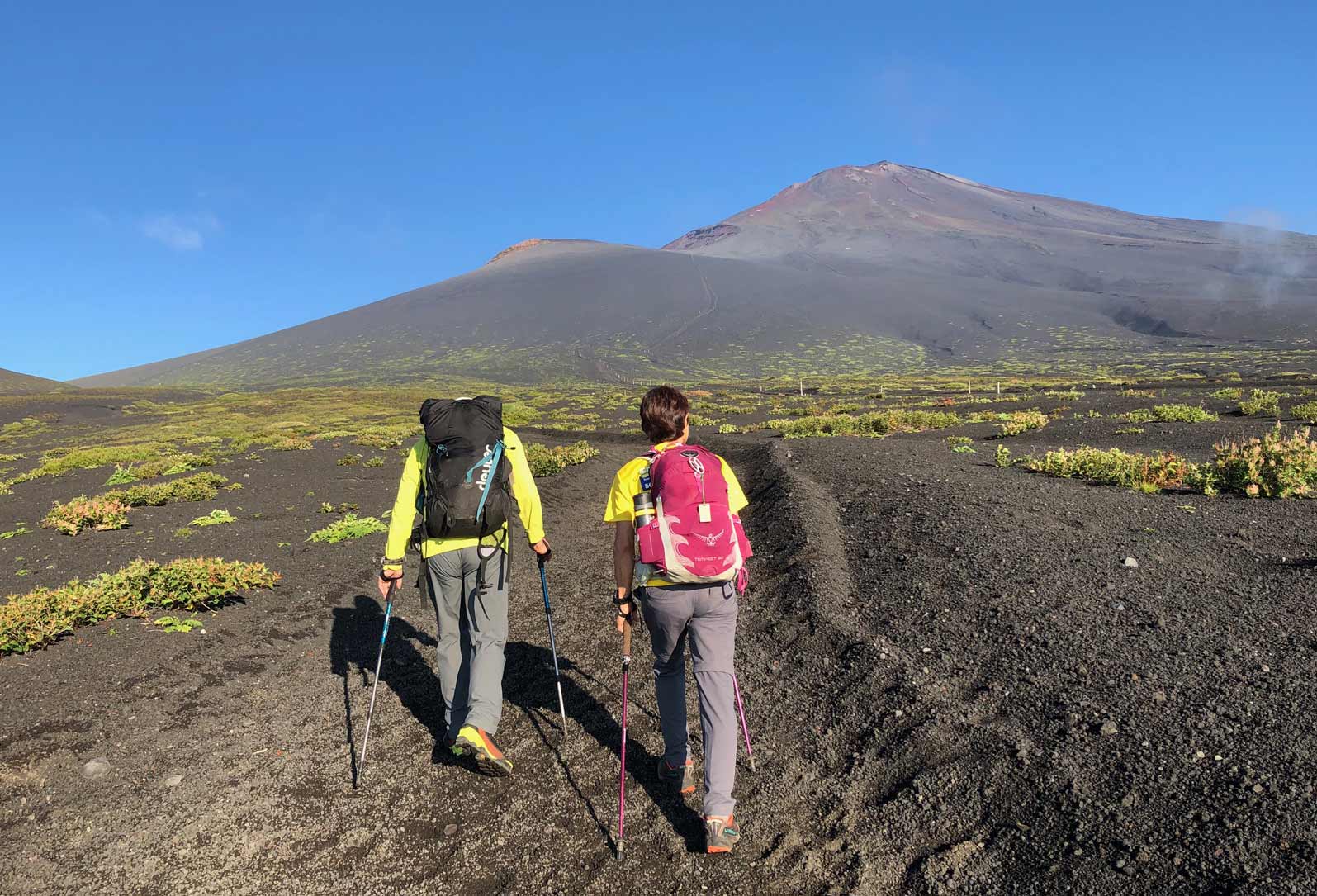
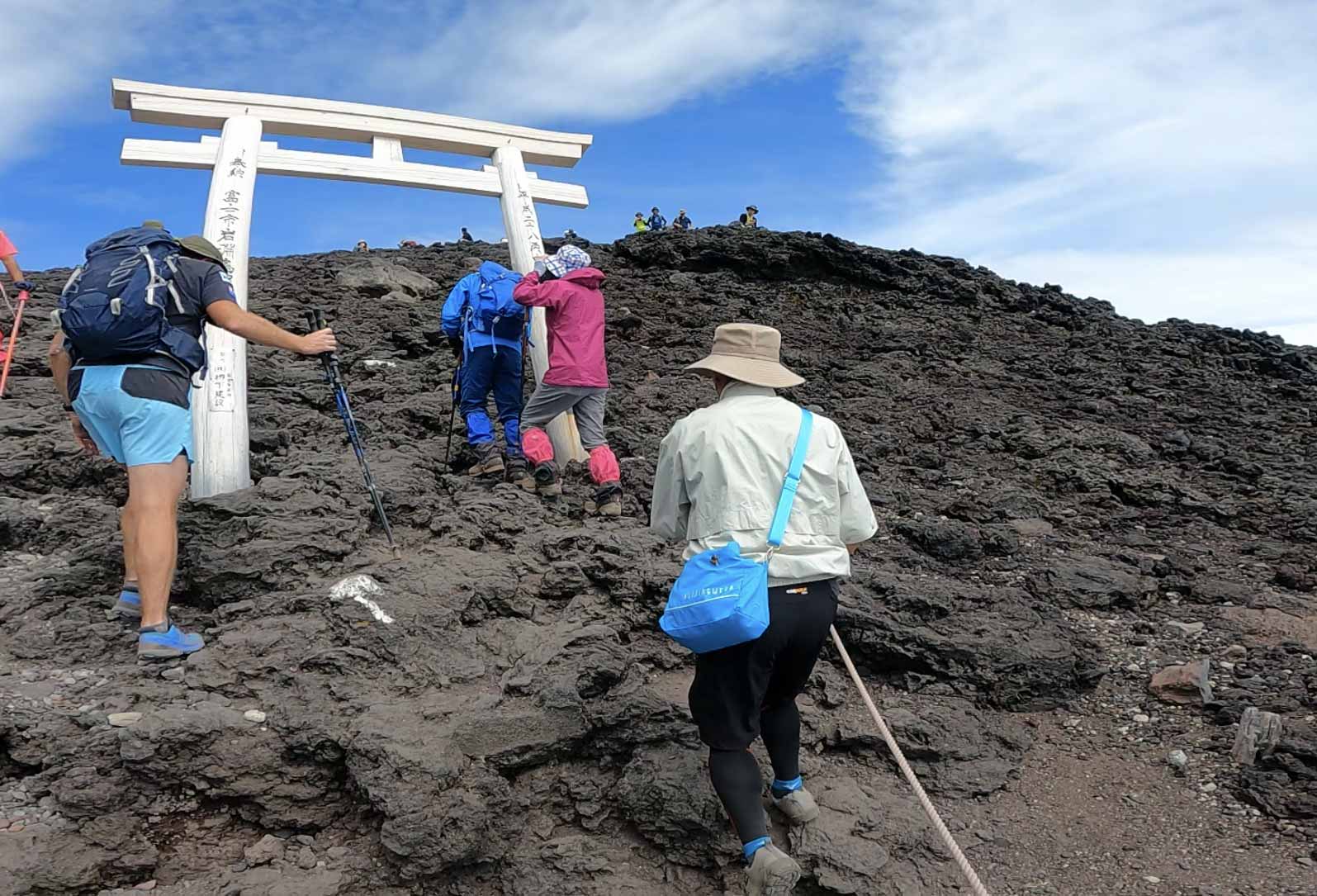
Duration
During the open season from early July to early September (the opening and closing times are sometimes dependent on the prevailing weather conditions), climbers will need just several hours to reach the summit. Staying in a hut is necessary for a day or more during weather warnings, especially strong winds.
Off-Season Climbing
Visitors can enjoy snowy mountaineering and back country skiing before the beginning of the climbing season. It is a lot more dangerous to climb Mt. Fuji during the off-season. All the trails are closed along with the huts. Furthermore, the temperature drops. Between autumn and spring, the slopes are covered with snow and ice beaten by the cold wind. The risk of fall is very high.
The UIAA Medical Commission strongly recommends not climbing Mt. Fuji during the off season without having conducted prior research and without having the necessary experience, equipment and proper plan.
In case of an accident or getting stranded, rescue teams are on hand. They will require details of your location and ascent/descent plan. All off-season visitors should complete and submit a climbing plan in which all the information is completed including the intended route, planned duration, number of people, schedule, list of equipment and contact information in case of emergency.
Please download the following document for specifics on how to apply.
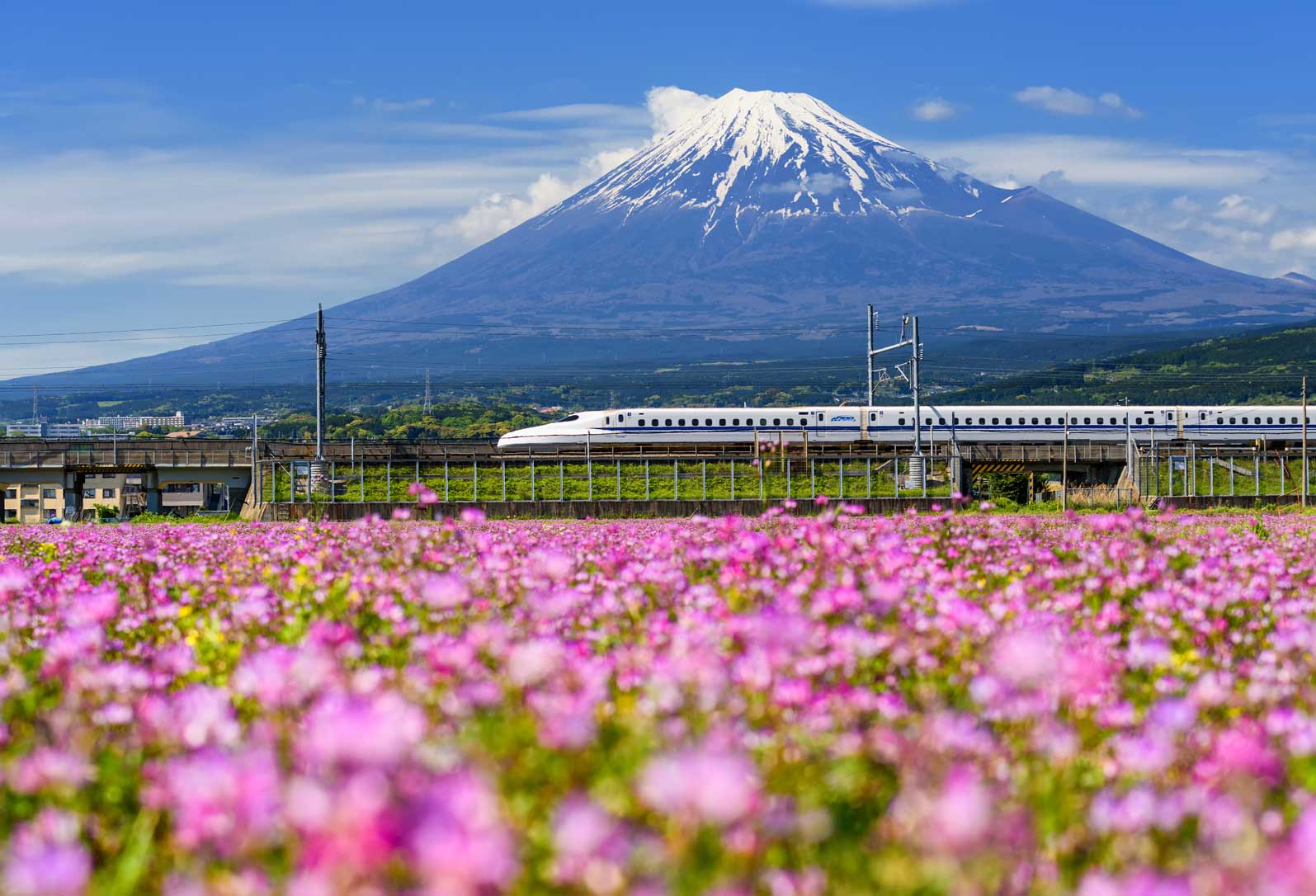
Essentials
Language
Japanese
Local Currency
Japanese Yen
Visa Requirements
For visa requirements please refer to your country’s Japanese embassy or visit the following website.
Nearest Hospital
Along Yoshida Trail, there are first-aid centers at the 5th, 7th and 8th stations. Along Fujinomiya Trail, there is a first-aid center at 8th station. No first-aid center along Subashiri Trail and Gotemba Trail.
Yamanashi Prefecture
Secondary emergency medical facility:
Fujiyoshida Municipal Hospital; 7-11-1 Kamiyoshida Higashi, Fujiyoshida City, Yamanashi Prefecture 403-0032
Tel: 0555-22-4111
Yamanashi Redcross Hospital; 6663-1 Funazu, Fujikawaguchiko Town, Tsuru-gun, Yamanashi Prefecture 401-0301
Tel: 0555-72-2222
Tertiary emergency medical facility: Critical care medical center, that accepts patients with severe symptom whom Secondary emergency medical facility cannot treat.
Yamanashi Prefectural Central Hospital; 1-1-1 Fujimi, Kofu City, Yamanashi Prefecture 400-8506, Tel: 055-253-7111
Shizuoka Prefecture
Secondary emergency medical facility:
Gotemba City Emergency Medical Center; 237-7 Nishitanaka, Gotemba City, Shizuoka Prefecture 412-0027
Tel: 0550-83-1111
Fuji City Emergency Medical Center; 217-2 Tsuda, Fuji City, Shizuoka Prefecture 417-0034
Tel: 0545-51-0099
Fujinomiya City Emergency Medical Center; 12-1 Miyahara, Fujinomiya City, Shizuoka Prefecture 418-0005
Tel: 0544-24-9999
Tertiary emergency medical facility: Critical care medical center, that accepts patients with severe symptom whom Secondary emergency medical facility cannot treat.
Numazu City Hospital; 550 Aza-Harunoki, Higashisuiji, Numazu City, Shizuoka Prefecture 410-0302
Tel: 055-924-5100
Shizuoka Redcross Hospital; 8-2 Otte-cho, Aoi-ku, Shizuoka City, Shizuoka Prefecture 420-0853
Tel: 054-254-4311
Evacuation
Should you suffer from acute mountain sickness (AMS, symptoms are headache, gastrointestinal upset, fatigue/weakness, and dizziness/light-headedness), you should not gain altitude. If symptoms are serious, descend the mountain. If it worsens, visit the first-aid center. There are first-aid centers at the 5th, 7th and 8th stations on Yoshida Trail, and the 8th station in Fujinomiya Trail. If you cannot descend the mountain by yourself, call the rescue services.
Yoshida Trail: Call 0555-72-1477 (Mt.Fuji 5th Sta. General Management Center)
Subashiri/Gotemba/Fujinomiya Trail: Call 0110 (police) or 0119 (fire/ambulance)
Another way is contacting the nearest hut.
Climbing Seasons
The standard climbing season is early July through early September. The open period of trails is typically announced on 1 July or later depending on the condition. Trails are closed in early September. The exact period of closing depends on the condition of the trails and weather. The opening and closing periods are different from trail to trail. Trails are closed temporarily due to stormy weather, landslides and so on even in opening season.
Communication
Antennas for mobile phones are located on Mt. Fuji during climbing season. It is possible to use phones even during the off-season. However mobile phone signal transmission might be poor from time to time, and from place to place, because the antennas in the mountain are removed in off-season.
Conditions
The temperature drops noticeably as you gain altitude from the 5th station to the summit (approximately minus 0.6 degrees Celsius per 100 m ascent). Winds also impact temperature by roughly minus 1 degree Celsius per 1 m/sec of wind velocity. So you will need layered clothing and rainwear. In the summer, you will have to prepare for dense fog, and be mindful of thunder and lightning.
During the off-season, accumulated snow becomes icy. This is dangerous, you cannot break your fall once you begin sliding down.
Technical Difficulty
Although you don’t need ropes to climb Mt. Fuji during the open season, you will have to react to a deterioration in the weather, strong winds and lightning, and sometimes make a decision to evacuate or take refuge in a hut.
You should be proficient in snow-mountaineering techniques such as walking with crampons, using ice axes and how to stop yourself sliding down in case of a fall.
Environmental Considerations
and Mountain Protection
The UIAA is committed to the protection of the mountain environment and has been since its founding in 1932. The UIAA Mountain Protection Commission was formed in 1969. Today the UIAA spearheads a number of projects related to sustainability in mountain regions including its annual Mountain Protection Award, through the work of its Climate Change Taskforce and its many international partnerships. For further details please visit: https://theuiaa.org/mountain-protection/
The UIAA encourages all climbers and mountaineers to consider their carbon footprint and adhere to local regulations and customs once on the ground.
If you climb Mt. Fuji during off-season, bring portable toilets, and bring back all trash. There is a ‘leave no trace’ culture. Due to overcrowding, there has been an increase in environmental issues throughout the past decade.
The following items are prohibited:
- Taking animals and plants
- Taking out stones or lava boulders
- Scribbling on the walls or stones
- Putting up a tent or lighting a bonfire
- Releasing pets
Dangers
- Rockfall is dangerous especially when you are ascending a crowded trail during the climbing season.
- Lightning is a serious problem everywhere.
- Strong sunshine can be an issue, and occasionally coldness becomes a problem even in the summer.
- Susceptibility to acute mountain sickness (AMS) is different from person to person. A slow and steady ascent is recommended in order to avoid getting AMS.
- Heavy winds are very dangerous especially in the snowy season. You are likely to slide far down the icy slope if you get blown over.
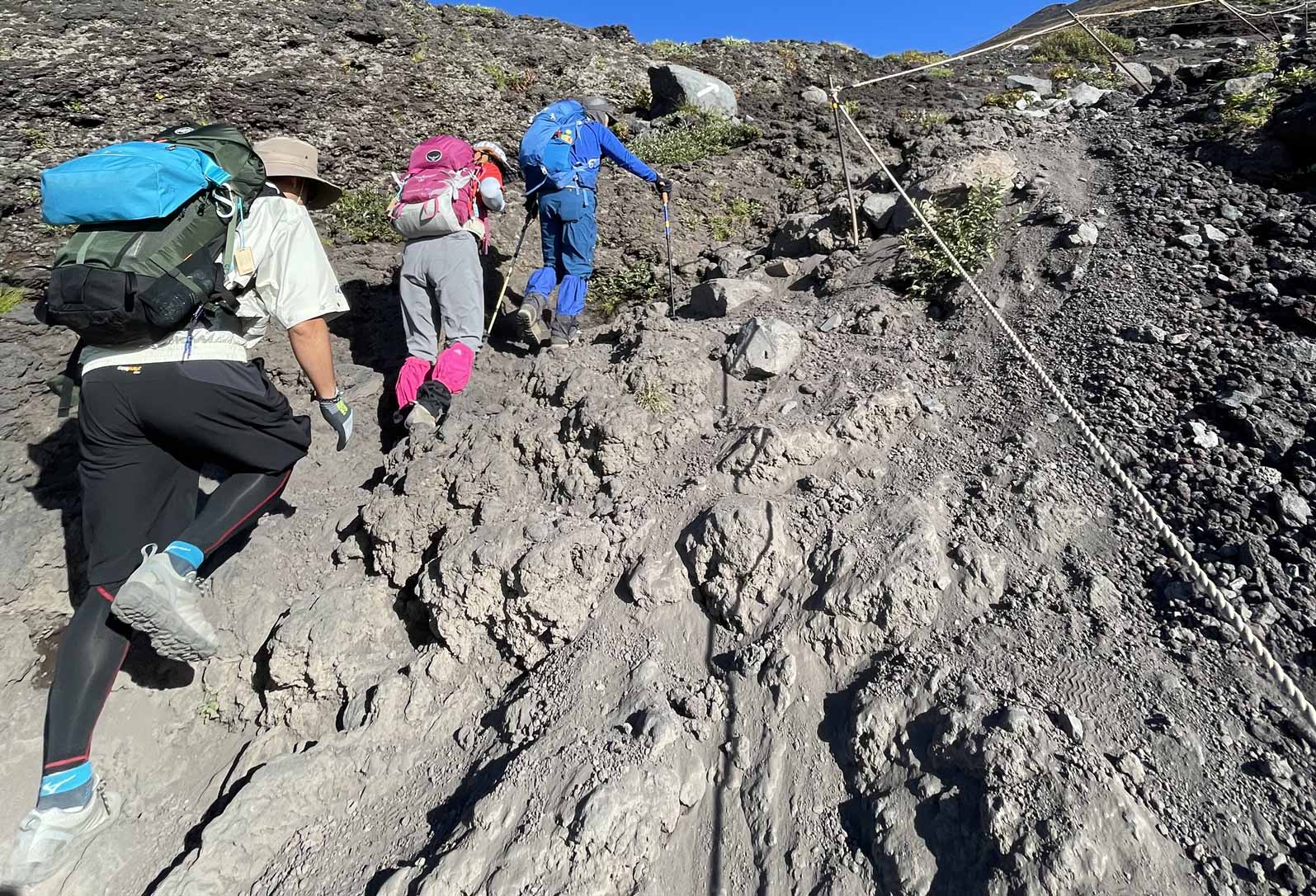
Using Safe
Climbing Equipment
A climb like Fuji, especially in the off season, requires preparation, training and planning. It also requires having the right equipment. The UIAA encourages all climbers to purchase certified equipment. The UIAA Safety Label is the only global certification for climbing equipment.
The UIAA Safety Label on a piece of climbing equipment means that samples of the equipment have been tested by an accredited, independent third party and shown to satisfy the requirements set forth in the UIAA standard. UIAA standards exist for over 25 times of climbing gear including ice axes, ropes and crampons.
Climbers can search for certified equipment through the UIAA’s dedicated database. Furthermore, the UIAA offers information on how best to purchase climbing equipment.
UIAA Skills Guide
The UIAA is committed to providing climbers and mountaineers with information to develop their skills, whether reinforcing lessons learned and not yet fully assimilated or to increase their technical knowledge and reduce the risks inherent to our sport. The UIAA Alpine Skills Summer guide was first published in 2015. Produced in collaboration with the Petzl Foundation, the guide and has been well received worldwide and is currently available in over ten languages. It covers a host of topics from route planning to frostbite, to reading the weather and climbing in a group. A winter version of the guide will be released shortly. The English language version can be purchased as a digital download here. Foreign language versions are available through UIAA member associations.
Additional UIAA
Medical Resources
MEDICAL ADVICE
Further Reading
Lead Authors – Norihiro Kamikomaki and Yudai Nomura
Images – courtesy of Stock Library, Norihiro Kamikomari and Yudai Nomura
All text and content is reviewed by a dedicated working group within UIAA Medical Commission. Discover more here.

